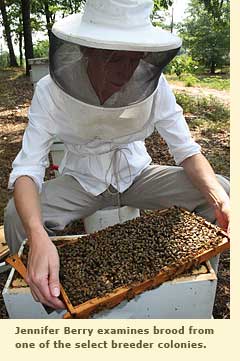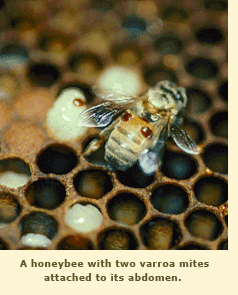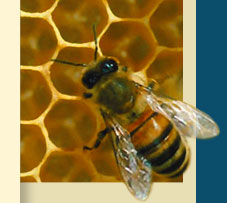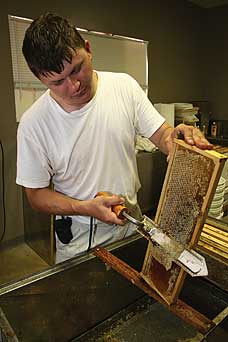What’s Killing All the Honeybees?
In Georgia and throughout the country, honeybees are mysteriously disappearing from commercial beekeepers’ hives. Among the suspects, some of which may be acting jointly, a recently identified virus stands out.
Across the United States, honeybees en masse have been leaving their hives to forage, as usual, and then failing to return—a highly unusual, and worrisome, occurrence. Even if the missing bees were in a field somewhere, they would be nearly impossible to find, said Keith Delaplane, a University of Georgia entomologist and honeybee expert, because the “foraging range of one bee colony is square miles, not square feet or even acres. If a bee doesn’t come home, you can’t simply find her and do an autopsy.”
 Although it is typical for beekeepers to lose 10 to 15 percent of their colonies each year because of problems such as mite infestations or disease, UGA apicultural research coordinator Jennifer Berry points out that the current phenomenon is far greater in scale and involves seemingly healthy hives. “When you have beekeepers who have lost 90 percent of their colonies, and they’re commercial and good beekeepers, we know something’s wrong,” she said.
Although it is typical for beekeepers to lose 10 to 15 percent of their colonies each year because of problems such as mite infestations or disease, UGA apicultural research coordinator Jennifer Berry points out that the current phenomenon is far greater in scale and involves seemingly healthy hives. “When you have beekeepers who have lost 90 percent of their colonies, and they’re commercial and good beekeepers, we know something’s wrong,” she said.
Tiny Bees Mean Big Bucks
In February 2007, the U.S. Department of Agriculture officially named the vanishing-bee problem “colony-collapse disorder” (CCD). At that time, many of the beekeepers reporting heavy losses from CCD were commercial migratory keepers spending the winter in California, Florida, Oklahoma, or Texas. But later that month, large non-migratory beekeepers started reporting serious losses as well.
Nationwide, 24 states have seen symptoms of CCD, and, increasingly, the vanished honeybees have found themselves in the media spotlight. What had once been limited to apicultural circles became a topic of conversation at water coolers and stories on the evening news. As a result, the public has learned that bees aren’t merely nuisances to swat at or limited in commercial utility to supplying us with honey. “Honeybees are essential for the pollination of more than 90 fruit and vegetable crops worldwide,” said Diana Cox-Foster, a Pennsylvania State University entomologist. “The economic value of the honeybee is about $14.6 billion in the United States alone.”
Without bees, flowers go unpollinated, crops don’t produce well, producers lose money, and consumers pay higher prices.
Nowhere is this effect felt more acutely than in California’s $1.5-billion almond industry. What Delaplane calls “the biggest pollination event on Earth” occurs every March, when the almond trees bloom. In anticipation, many of the nation’s 1,000 or so migratory beekeepers stack their bee boxes on pallets, load them onto tractor-trailers with forklifts, cover the load with netting, and drive the hives—at night, when the bees are calm—to California, and park in acres-sized lots that serve as home base for the billions of bees.
Given this mobile pollination service, the state’s almond trees generate some 2,400 pounds of almonds per acre, calculates Hannah Nordhaus of High Country News. Without the bees, they produce a mere 40 pounds per acre. Moreover, almonds are only one crop out of many: a third of U.S. crops depend on bees for pollination. Another way to look at it, says Berry, is that “one out of every three bites [of food] a human takes is directly thanks to a bee.”
Examining the Suspects
Delaplane thinks that some of the blame for CCD may lie with the migrating beekeepers themselves. “If you winter your bees in Texas, move them to California in March for almonds, then to Oregon for cherries, then to Washington for apples, then to North Dakota for clover,” he said, “the bees are active half the year.” Like overworked humans, many of them get worn out and become more vulnerable to disease. In stationary hives, by contrast, worker bees spend only about six weeks of the year collecting. The spring nectar flow allows them to produce enough honey to last the other 46 weeks. “[Massive] bee movement is fine for a season, but it’s just not sustainable,” said Delaplane.
He cites other suspects as well: shrinking bee-food supply (for example, from loss of habitat as a result of commercial development or urban expansion); parasitic mites; unanticipated side effects of pesticides; and a recently identified virus—the Israeli acute paralysis virus (IAPV). Delaplane, along with Berry and a rotation of UGA graduate students, are addressing colony-collapse disorder by examining these potential causes one by one.
In the case of shrinking food supply, Delaplane said, “it’s why we advocate more complex, bee-friendly agricultural habitats” that don’t focus on just one crop.
When tracheal mites came onto the bee scene in 1984, “it was the first time in history that beekeepers became pesticide users,” he said. “They went from pesticide-averse to pesticide-dependent virtually overnight.”
 Then, when varroa mites arrived, “the only thing saving colonies was pesticides,” according to Berry. “Because of the mites, the wild-bee population declined about 90 percent. But because the chemicals were quick and easy, they largely saved beekeepers’ colonies. Still, we knew at some point it was going to be a problem.”
Then, when varroa mites arrived, “the only thing saving colonies was pesticides,” according to Berry. “Because of the mites, the wild-bee population declined about 90 percent. But because the chemicals were quick and easy, they largely saved beekeepers’ colonies. Still, we knew at some point it was going to be a problem.”
This past summer, scientists identified IAPV, new to the United States via Australia, as one of CCD’s causes. The researchers who implicated the virus are very careful to call it a “marker” of the disorder, Delaplane said. “But the stats are very convincing, with literally every colony showing symptoms of CCD also harboring the virus. We don’t usually find data that plain.”
When the embargo was lifted on bee imports in 2004, it was the first time Australian bees had entered the United States since the 1920s. With no signs of problems, Australian colonies were presumed safe. And they were safe, even with IAPV, because the varroa mite, which entered the U.S. in 1987, hasn’t made it to Australia. “There is evidence that the virus doesn’t express symptoms until the varroa mites feed on the bees,” Delaplane explained.
With no cure for varroa mites and no vaccine for IAPV, the next best thing might seem to keep sick bees separate. But for some beekeepers, that would be operationally and economically unfeasible. “The tail that wags the dog is the California almond industry,” Delaplane said. “It’s a huge mixing pot” that inevitably involves the intermingling of billions of bees.
Some Practical Advice
Delaplane sees a better way through practices that don’t expose bees to the deleterious affects of chemicals. “The best advice we can give Georgia beekeepers,” he said, “is to adopt the integrated pest management strategies, many of which were developed here at UGA, for controlling varroa mites.”
He tells beekeepers to use Russian and hygienic lines. Russian bees have natural characteristics that make them resistant to mites, while hygienic bees can detect brood (developing bees that have not yet emerged from their cells) with mites and “throw it out the door,” Delaplane said.
Second, he tells them to install screened, rather than solid floors, because many of the parasites may fall through screened floors and then be unable to return to the hive.
Next, beekeepers should keep their hives in full sun, Delaplane said. “There are at least two independent experiments from other institutions that suggest colonies in sun have fewer mites.”
By dusting bees periodically with powdered confectioner’s sugar, beekeepers can elicit a grooming response in bees that dislodges the mites.
And finally, there are a number of ways in which beekeepers can physically “trap” numerous mites and dispose of them.
Delaplane also looks to genetics for some answers. “Israeli literature,” he pointed out, “shows that some of their bees have a genetic resistance to IAPV.” Taking systematic advantage of this trait could be a powerful tool, but so far the industry has been slow to pursue it.
For more information about managing honeybees, visit www.ent.uga.edu/bees
(Stephanie Schupska is a public relations coordinator in UGA’s College of Agricultural and Environmental Sciences).
 |



